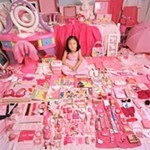Painting Race
Getting Inside Michael Ray Charles' Provocative Images
By Rebecca S. Cohen, Fri., Oct. 24, 1997
 |
 |
 |
Some folks question whether this is possible. Clearly Charles hasn't convinced Roberta Smith. The New York Times art critic says that his subject matter "is not enough to raise [the paintings] above the level of clever, stylish calculation." When the exhibition opened at the Blaffer Gallery at the University of Houston, a panel discussion hosted by the gallery drew an audience of some 500 people, many of whom were not sympathetic to the artist's approach. And some of Charles' old friends in Houston imply that the artist is not really in control of this imagery. In the summer issue of ArtLies magazine, they accuse him outright of trading on negative stereotypes about blacks, invented by whites, to make a buck. Artist Garry Reece says that his children's self-esteem is somehow threatened by visiting Sambo, et al., in the paintings (see sidebar).
Michael Ray Charles contends that you have to open up old stereotypes and lay them out, superimpose them on top of today's world, in order to understand them, to have any chance at all of truly making them go away. "The past is present," he says with each new painting. Burning all the books about Sambo and tossing Aunt Jemima into history's trash heap isn't going to make them disappear. Charles paints Aunt Jemima wearing a Wonder Woman costume or standing in a sexy pose like Marilyn Monroe with the wind whooshing up her skirt, only wearing floppy pink slippers on her feet and a red and white polka-dot kerchief tied on her head. His Michael Jackson wears a jester's cap with little Sambo faces at each point instead of bells. In Charles' Liberty Bros. Permanent Daily Circus posters, figures named Dawg Boy and Sealboy perform for the crowd. In Charles' puzzle painting Join the Club, three little Sambos feast on basketballs with a juicy red filling that looks suspiciously like watermelon. The painting reads: Join the Club. You'll have a ball. A piece of the puzzle is missing.
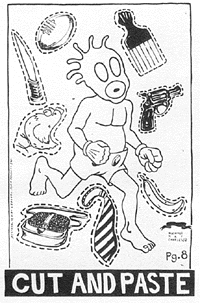 The piece of the puzzle missing for me has to do with each viewer's ability (or lack thereof) to dig beneath the surface. How must young black children respond to these stereotypes shucking and jiving in paintings made to look like movie posters, magazine covers, circus posters, and even children's puzzles? Can they really understand that criticism is being leveled at the culture which invented and perpetuates these images, not at the children who inherited them? In Houston, Don Baciagalupi, the show's curator and director of the Blaffer Gallery, invited hundreds of children of all ages to see the exhibition. The gallery trained docents to guide them through the work. The Austin Museum of Art, while stepping up to the plate and hosting the exhibition when the Texas Fine Arts Association couldn't do it (its new downtown exhibition space is not yet complete), has declined to reach out in the same way. Certainly, school groups with young children will not be turned away, but they are hardly being encouraged to attend. The museum prefers to leave the responsibility of discussing these images with children to parents. During a recent tour of the exhibition, several parents agreed enthusiastically with that policy, one saying that she didn't want someone "outside of my culture" to explain this art to her children. Other African-Americans who volunteered comments at museum educational events supported the artist's message, though they cringed at his methods: all those basketballs and watermelons and footballs and dollar signs, all those mammies and Sambos to remind them of how the majority culture keeps hurtful stereotypes alive. Or is the artist saying that the black community itself perpetuates these images? I'm part of the artist's white audience. I can only read the work in this exhibition through my own experience.
The piece of the puzzle missing for me has to do with each viewer's ability (or lack thereof) to dig beneath the surface. How must young black children respond to these stereotypes shucking and jiving in paintings made to look like movie posters, magazine covers, circus posters, and even children's puzzles? Can they really understand that criticism is being leveled at the culture which invented and perpetuates these images, not at the children who inherited them? In Houston, Don Baciagalupi, the show's curator and director of the Blaffer Gallery, invited hundreds of children of all ages to see the exhibition. The gallery trained docents to guide them through the work. The Austin Museum of Art, while stepping up to the plate and hosting the exhibition when the Texas Fine Arts Association couldn't do it (its new downtown exhibition space is not yet complete), has declined to reach out in the same way. Certainly, school groups with young children will not be turned away, but they are hardly being encouraged to attend. The museum prefers to leave the responsibility of discussing these images with children to parents. During a recent tour of the exhibition, several parents agreed enthusiastically with that policy, one saying that she didn't want someone "outside of my culture" to explain this art to her children. Other African-Americans who volunteered comments at museum educational events supported the artist's message, though they cringed at his methods: all those basketballs and watermelons and footballs and dollar signs, all those mammies and Sambos to remind them of how the majority culture keeps hurtful stereotypes alive. Or is the artist saying that the black community itself perpetuates these images? I'm part of the artist's white audience. I can only read the work in this exhibition through my own experience.
One painting that speaks to me with particular force is rewopetihW (white power). In between the words ETIHW and REWOP, written large, a Sambo is consuming a watermelon. He wears a big watermelon smile. The support for the painting looks like a banner, perhaps a flag, charred and burned at the edges. There is nothing accidental about this damage, but who is disrespecting whom? Why is the writing backward? The curator leads a crowd through a series of guesses. Finally, someone suggests that it might be like a mirror image or words written on a window. "Which side of the message are you on?" this picture asks. The artist expects us to think about such things, no matter which side we're on. So, where do I stand?
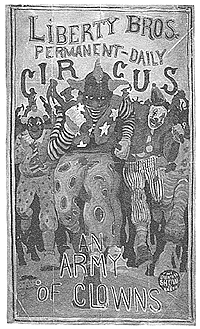 Look at the black men -- gorgeously painted, of course, with cool, soothing greens and blues -- marching right out of the picture frame in Army of Clowns, charging toward the viewer, claw hammers in each hand. The paint is well handled as usual, and the composition is complex. The image is complex as well, calling me to it every time I visit the galleries, daring me to guess at its meaning. This painting makes me particularly nervous. I feel threatened, not by the black men rushing toward me with hammers, but by my own culpability. I do rely on stereotypes to inform my experience with strangers. I squirm, uncomfortable, admonished by all the images around me. But then, self-discovery is what looking at art is all about. The more personal the experience, the better. Looking at art should stimulate a conversation between the viewer and the work at hand (a rowdy exchange is certainly preferable to no dialogue at all), and words that linger, even when you're no longer in the presence of the work, suggest that permanent changes have occurred.
Look at the black men -- gorgeously painted, of course, with cool, soothing greens and blues -- marching right out of the picture frame in Army of Clowns, charging toward the viewer, claw hammers in each hand. The paint is well handled as usual, and the composition is complex. The image is complex as well, calling me to it every time I visit the galleries, daring me to guess at its meaning. This painting makes me particularly nervous. I feel threatened, not by the black men rushing toward me with hammers, but by my own culpability. I do rely on stereotypes to inform my experience with strangers. I squirm, uncomfortable, admonished by all the images around me. But then, self-discovery is what looking at art is all about. The more personal the experience, the better. Looking at art should stimulate a conversation between the viewer and the work at hand (a rowdy exchange is certainly preferable to no dialogue at all), and words that linger, even when you're no longer in the presence of the work, suggest that permanent changes have occurred.
Unlikely as it may seem, Michael Ray Charles' provocative use of racially charged images has put him on the fast track in the American art scene. When I first met the artist in 1993, he was not 30 years old and delighted to have been hired to teach at the University of Texas at Austin. At the time, Charles painted in a tiny room in the modest house he shared with his wife and young son, and was content to wait and see what Tony Shafrazi, the New York dealer who'd shown interest in his work, would do for him.
A lot has transpired in four years. Shafrazi's Manhattan gallery hosted a solo exhibition of Charles' work in 1994 and is hosting another one this month, as is Moody Gallery in Houston. Courtesy of Shafrazi, Charles and his family have traveled several times to Europe, where his work has been exhibited and well received. His dealers regularly sell out his shows, and because they do, prices for his works are on the rise and museum curators are noticing his work and scheduling exhibitions like this one. After its Austin run, "Michael Ray Charles 1989-1997: An American Artist's Work" travels to Cincinnati, Ohio and Buffalo, New York. Acclaimed filmmaker Spike Lee wrote the introduction to the exhibition catalogue -- a spectacular four-color poster portfolio with accompanying text-filled paperback book -- and asked Charles to design the poster for his documentary 4 Little Girls. Not too long ago, Charles and his family -- he has two sons now -- bought a new home, and he's taken a semester off from teaching to paint in his new studio. Michael Ray Charles is still not 30 years old.
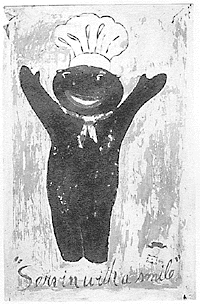 So why do art collectors pay money to live with his stuff? Perhaps they find it beautiful. Certainly it is technically proficient; the figures are beautifully drawn and the paint applied with unerring skill. But do the folks who can afford to pay big prices for paintings that hang in museums and New York galleries -- most often rich white collectors -- give a damn about the artist's message? Has Michael Ray Charles sold out because he has secured a place in the food chain that not only supports his family and his painting habit but assures that his ideas will travel worldwide? Does it matter? All artists whose work is political must deal with this particular paradox, unless they choose to work in such a conceptual way that there are no objects for collectors to possess at any price.
So why do art collectors pay money to live with his stuff? Perhaps they find it beautiful. Certainly it is technically proficient; the figures are beautifully drawn and the paint applied with unerring skill. But do the folks who can afford to pay big prices for paintings that hang in museums and New York galleries -- most often rich white collectors -- give a damn about the artist's message? Has Michael Ray Charles sold out because he has secured a place in the food chain that not only supports his family and his painting habit but assures that his ideas will travel worldwide? Does it matter? All artists whose work is political must deal with this particular paradox, unless they choose to work in such a conceptual way that there are no objects for collectors to possess at any price.
In this case, the artist paints pictures that equal the sum of his experience filtered through a deep and sensitive intelligence. A middle child from a big family in which his father's presence was positive and consistent, Michael Ray Charles studied advertising in college and played basketball. He is still close to his siblings, although most don't understand his work. His wife and sons accompany him everywhere, although she too questions his imagery sometimes. His work, while hardly autobiographical, speaks volumes about how his own life has been shaped by expectations based on racial stereotypes. He is less angry than analytical, more a cultural historian than a prophet, although there are plenty of flailing arms and rent garments in these paintings.
"I confuse people," Charles admits when we meet for lunch after the Austin opening. This is the first and most poignant example of the dualities which describe both the artist and his extraordinary body of work. He is obsessed with communication, eager to talk one-on-one with just about anyone to explain his point of view, and yet he makes paintings that are so multi-layered and charged that a quick read of any of them would be a mistake. What you see first is rarely what he's getting at.
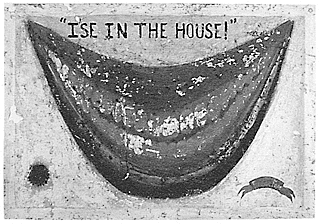
It's hard to make direct reference to racial stereotypes in today's politically sensitive world, then to convince the public that your heart is in the right place. Ask Lino Graglia. Ask Michael Ray Charles, who lures the viewer into his work by pairing racially charged images with seductive artistic elements. He fits these into visual formats we've been trained all our lives to recognize and accept. He juggles words and letters and pictures to create a body of work all about packaging, encoding, and transmitting information. Selling lies.
Painting these pictures has meant that Michael Ray Charles inhabits a solitary position in the art world, at least for the time being. He has lost his Houston art chums and is not yet intimate with Shafrazi's international art set. He lives half a continent away from most of the young artists (Kara Williams and Kerry James Marshal, for example) who are matriculating as fast as he is through the art world. And he is nearly half a century younger than Tucson resident Robert Colescott, the first African-American to singlehandedly represent the United States in this year's Venice Biennale. Colescott says his own paintings "are not about race, they are about perception." Standing in the midst of them in the U.S. Pavilion in Venice, it was hard to hold that thought in my head, just as it may be difficult to accept that Charles' paintings are about images rather than people. Like Colescott and like Austin's Peter Saul, Michael Ray Charles seems bent on producing edgy, figurative, world-class art away from the New York scene. His new friends in Austin tend not to be artists.
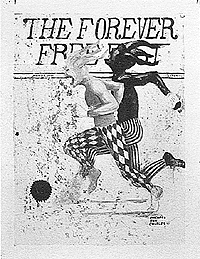 Asked who he would choose if curating a regional exhibition of black artists, Charles reveals more about himself than the imaginary exhibition. "I'd look outside of what has been defined as art," he says almost immediately, "at designers, welders, folk artists, musicians." He is similarly hard pressed to come up with other artists -- black or white, living or dead -- whose work he looks to for inspiration, preferring instead to mention his love of music and his fascination with words and numbers, which play ever expanding roles in his work. The criticism he received in Houston has clearly taken its toll.
Asked who he would choose if curating a regional exhibition of black artists, Charles reveals more about himself than the imaginary exhibition. "I'd look outside of what has been defined as art," he says almost immediately, "at designers, welders, folk artists, musicians." He is similarly hard pressed to come up with other artists -- black or white, living or dead -- whose work he looks to for inspiration, preferring instead to mention his love of music and his fascination with words and numbers, which play ever expanding roles in his work. The criticism he received in Houston has clearly taken its toll.
How did you get so old so fast? I ask him. He concedes the truth of the question, but is hard pressed to give an answer. Somewhere, early on, Michael Ray Charles stepped away from the ready-to-wear images with which he was presented growing up and became an artist. Now he is trying on (and often rejecting) the stereotypes that come with the artist's life.
In a new painting at Moody Gallery in Houston, a clown performs wearing a blindfold covered with dollar signs. Although the dumbbells he is juggling crash toward the floor and a huge hook threatens to pull him offstage, he is laughing. The painting is called JOY/PAIN. It is constructed and painted to look like a puzzle. In this one, all the pieces are in place. Perhaps the painting is about the juggling act that artists perform as they make paintings and seek an audience for their work. Is this guy blinded by money? Is commercial success good or bad? I close my eyes and take another look at the painting that is stored, albeit imperfectly, in my memory. As always, the artist's signature penny is glued to the canvas, the only coin that is different in color from the others, the one with the lowest face value. On the penny, head side up, Abraham Lincoln faces in the opposite direction from all the other portraits on coins.
"Michael Ray Charles 1989-1997: An American Artist's Work" is on view at the Austin Museum of Art Downtown, 823 Congress, through December 14. Call 458-8191 for info.






